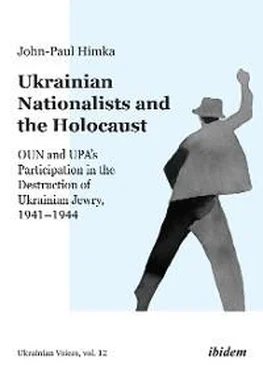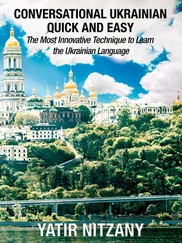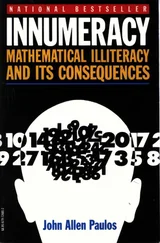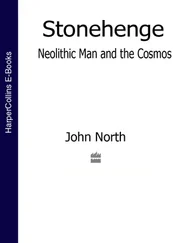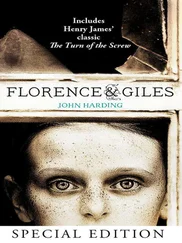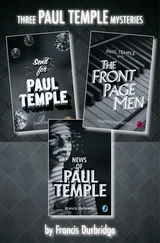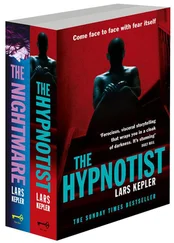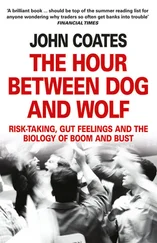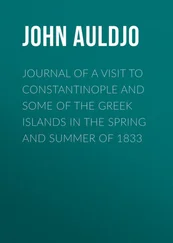Only a few years passed before this beautiful tale was exposed as a fabrication. Friedman made an investigation into the memoir. When it was republished in Buenos Aires in 1957, a prominent Melnykite, Dmytro Andriievsky, filled in a bit more of Stella Krenzbach’s life story. In Israel, he wrote, she went to work as a secretary in the ministry of foreign affairs. 129She first published her memoirs in the Washington Post , and a few weeks later she was murdered. Here is what Friedman discovered: “I checked the Washington Post of that period and did not find the memoirs. At my request, Dr. N.M. Gelber of Jerusalem made inquiry in the foreign ministry there; the reply was that the ministry had never had an employee by that name and that such a case of homicide was entirely unknown. Moreover, a careful analysis of the text of the ‘memoirs’ has led me to the conclusion that the entire story is a hoax.” 130One of the dviikari , Bohdan Kordiuk, also looked into the Stella Krenzbach question. His conclusion was very similar. He asked the UPA veterans he knew if they had known or heard of her; none had. In his opinion, “the tale of Dr. Stella Krenzbach has to be considered a mystification.” 131
But decades passed, Ukraine became independent, connections with the Ukrainian diaspora intensified, and some Western Ukrainians were calling for the rehabilitation of OUN and UPA. Not surprisingly, then, in 1993, a periodical connected with the Vasyl Stus Memorial Society in Lviv, Poklyk sumlinnia , reanimated Stella Krenzbach by republishing her memoir. The memoir fit perfectly with Zhanna Kovba’s goal to give the lie to stereotypes of antisemitic Ukrainians and communist Jews, and she accepted it as good coin. 132Volodymyr Viatrovych also cited her memoir in his 2006 book on OUN and the Jews to demonstrate the presence and acceptance of Jews in UPA. 133Then as the controversies around OUN and UPA heated up near the end of Viktor Yushchenko’s presidency, the Ukrainian-language Jewish poet Moishe Fishbein did a great deal to publicize the Krenzbach story. He gave a conference paper, frequently reprinted/reposted at the time, entitled “The Jewish Card in Russian Operations against Ukraine,” which used the Krenzbach memoir to counter Russian claims that UPA was antisemitic. He also put the Krenzbach memoirs on his website in Ukrainian and in English translation. 134Fishbein’s efforts took in many people. 135
* *
*
The controversies over the legitimacy of sources reaffirm the need to treat sources with care. In our survey, we saw the limitations and problems with every kind of source we looked at. The German documents do not constitute, as earlier Holocaust scholars believed, the touchstone of truth; instead they are marred by deep biases. Soviet documents are formulated using an ideological vocabulary and, more important, sometimes tailored information to serve the needs of the state. Internal OUN documents are much more reliable than documents produced for external consumption. Moreover, the researcher has to be careful about deliberate misrepresentation and even falsifications by OUN. Crucially, official documents of every provenance need to be triangulated, whenever possible, with other evidence, primarily eyewitness testimony, but also when relevant with photographs, films, and the periodical press. Jewish testimony is often marked by trauma and Ukrainian testimony by evasion. All sources need to be treated with care. Some sources, moreover, have imbedded problems as products of criminal practices: German documents and photographs are components of the atrocities they report on, and Soviet interrogations have their origins in torture. Questions around sources are not simple, but it is hoped that this survey has armed the reader with sufficient understanding to make reasonable judgments about the utility and reliability of the various sources and about the historical processes which they reflect.
1There is actually a wonderful finding aid prepared along these lines: Berkhoff, “Ukraine under Nazi Rule.”
2Ilnytzkyj, Deutschland und die Ukraine 1934-1945 .
3Armstrong, Ukrainian Nationalism , 39 n. 29.
4Friedman, Philip. “Ukrainian-Jewish Relations,” 181, 196 n. 15. EM, no. 126, 27 October 1941; translation from Einsatzgruppen Reports , 210.
5 OUN v svitli postanov .
6See below, 163, 165, 170-71, 225-26.
7Berkhoff and Carynnyk, “The Organization of Ukrainian Nationalists,” 177 n. 30.
8 Zlochyny komunistychnoi Moskvy .
9Yevhen Stakhiv has related that in December 1941 he passed on a letter from the leader of one faction of OUN, Stepan Bandera, who was then imprisoned by the Gestapo in Berlin, to the underground head of OUN-B in the Homeland, Mykola Lebed, instructing OUN not to antagonize the Germans and to try to repair relations with Germany. About forty years later, Stakhiv reminded Lebed, who was then the leader of the dviikari , of Bandera’s instructions, but Lebed claimed not to remember them. Again about five years later Stakhiv raised the subject with Lebed, and this time he allegedly answered: “Yes, I remember. But I didn’t want you to tell people about it. It is not necessary for history to know the truth.” Stakhiv, Kriz’ tiurmy , 99-100. Although this story does seem to characterize the dviikari ’s attitude to history, I lack faith in Stakhiv’s reliability as a memoirist. The incident has been accepted as genuine, however, by Grzegorz Rossoliński-Liebe, “Ukrainian National Revolution,” 106; Stepan Bandera , 41.
10Kurylo and Himka, “Iak OUN stavylasia do ievreiv,” 259.
11 http://resource.history.org.ua/cgi-bin/eiu/history.exe?&I21DBN=ELIB&P21DBN=ELIB&S21STN=1&S21REF=10&S21FMT=elib_all&C21COM=S&S21CNR=20&S21P01=0&S21P02=0&S21P03=ID=&S21STR=0013098, accessed 23 October 2018.
12Berkhoff, Harvest of Despair , 287 and 428 n. 63.
13See above, 31-38.
14See above, 52.
15Serhiichuk, OUN-UPA v roky viiny , 311-12.
16Artizov, Ukrainskie natsionalisticheskie organizatsii .
17There is a very interesting book on the RHSA: Wildt, An Uncompromising Generation .
18Headland, Messages of Murder .
19DALO, fond R12, op. 1.
20For more context on this, see Himka, “Legislating Historical Truth.”
21USHMM, Acc. 1995.A.1086, RG-31.001M.
22I am grateful to David Alan Rich for sharing a copy of the militia files with me.
23There are also regional SBU archives that I have not consulted, but the younger generation of Ukrainian historians (e.g., Marta Havryshko, Roman Shliakhtych, and Andrii Usach) has been making good use of them in their publications.
24This problem is fleshed out more fully in Solonari, “Patterns of Violence,” 54-55.
25Statiev, The Soviet Counterinsurgency , 247-48. We now have an excellent account of the methods used by the NKVD during the late 1930s in Soviet Ukraine based on NKVD interrogators’ own admissions of “violations of socialist legality”: Viola, Stalinist Perpetrators on Trial . See also a wrenching study of Stalinist interrogations in postwar Poland that was able to explore the issue more from prisoners’ perspectives: Chodakiewicz, “The Dialectics of Pain.”
26This comes out very clearly in Viola, Stalinist Perpetrators on Trial .
27Bohunov, Mytropolyt Andrei Sheptyts’kyi .
28Dumitru, “Analysis.”
29Solonari, “Patterns of Violence,” 54-55.
30Prusin, “‘Fascist Criminals to the Gallows!’” 18.
31Penter, “Local Collaborators on Trial,” 21. See also Penter, “Collaboration on Trial.”
32Comments of Tanja Penter in Coleman, “Roundtable,” 235-37.
33This is the same period in which the Soviets published the English-language tracts that appeared under the name Valerii Styrkul. See above, 42.
Читать дальше
